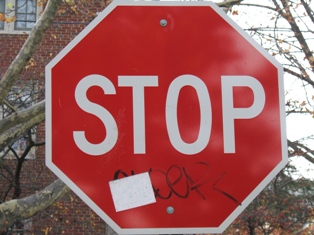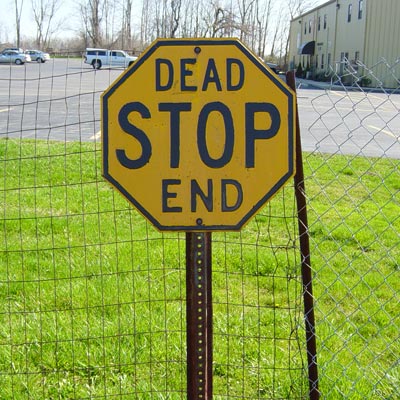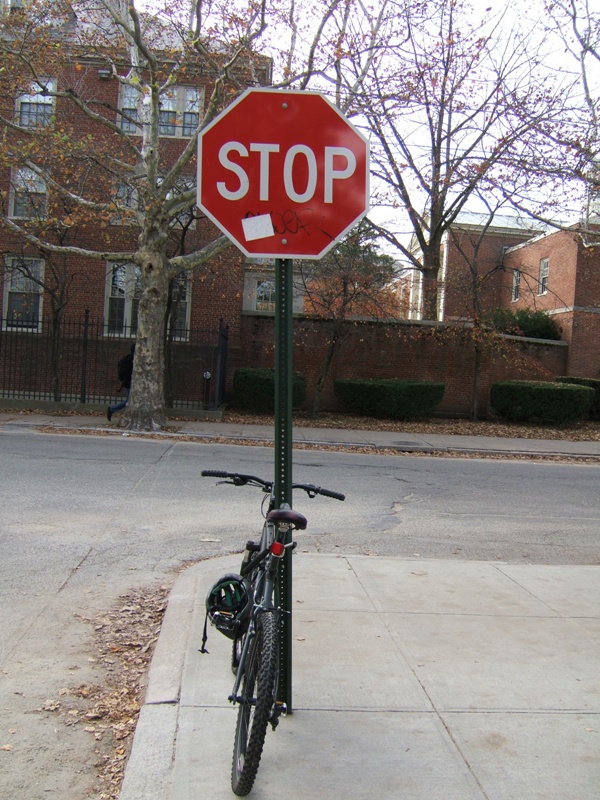The Stop Sign

Do you really want to continue? Does this image make you want to look to the left and the right of the stop sign? What is the history of the stop sign and why do we respond to it the way we do?
As you read the following page, think about what the plethora of stop signs is doing to your desire to continue reading. You want to scroll down the page some more, but the stop signs keep telling you not to. While stop signs have been designed as automotive traffic management devices, they have escaped this specific, narrow mode of functionality and moved on to become an image, symbol and power in its own right. In Latour, B. 2002: Morality and Technology Theory, Culture & Society 19(5/6) 247-60, he argues "We never tame technologies, not because we lack sufficiently powerful masters, not because technologies, once they have become ‘autonomous’, function according to their own impulse, not because, as Heidegger claims, they are the forgetting of Being in the form of mastery, but because they are a true form of mediation. Far from ignoring being-as-being in favour of pure domination, of pure hailing, the mediation of technology experiments with what must be called being-as-another." What I feel this means is that, as with any technological achievement (or honing in even further, perhaps as with any thing), you are not able to maintain a just set-it-and-forget-it mentality. Once the achievement leaves the purview of its creator, once the thing leaves the confines of a person (the creator, the founder, the inventor, the laborer), the ability to define and dictate how people react to it is lost forever.
Take for example the lowly stop sign. Perhaps some scientist at 3M created a reflectorized material many years ago. His visions for how people would interact with it would perhaps shape how he viewed it and presented it. Perhaps, though, an engineer then took the material and decided that it would be perfect for putting on bicycle reflectors. This engineer then viewed the material differently, and presented it that way. Next in line we might see the engineer's boss, who upon seeing the bicycle reflector decides that this would make stop signs brighter and therefore safer. Let's take this thought process a few years forward now, to the present, when a technician at the Providence DOT Traffic Engineering Department takes this material and uses the stop-sign making machines to make a stop sign. This technician might view the reflectorized material as a cog in the wheel, input needed to create output, perhaps the last thing keeping him from punching out for the day. This material, now enmeshed and embedded in a stop sign, is installed by some DOT workers, at a quiet intersection that has never had a stop sign before. The workers view the stop sign as a very small component of their work order. They have to drive to the location with their equipment and tools, they have to dig a hole, pour some concrete perhaps, set the stop sign and secure it. For the workers, the stop sign could just as well have been a street or yield sign. Penultimately, the residents surrounding this quiet intersection now must change their driving behavior, and one would go so far as to use the phrase 'change their lives', in order to accommodate this new stop sign. Some neighbors might find it an intrusion, others a nuisance and still others might find it a godsend, in part depending on how they currently view the intersection. Finally, the new stop sign requires enforcement, so to a police officer assigned to watch the intersection to make sure the new stop sign is being followed may not even see the stop sign. From his point of view, the stop sign doesn't even need to exist; he only looks for vehicles that don't stop. Without the stop sign, the police officer would not be there, but the police officer doesn't care about the stop sign and isn't there to observe it, only to observe that it is being observed.
So, from the laboratory to the intersection, we see that each person's reaction to and worldview of the stop sign (and its progenitors) will not determine the next person's reaction or worldview. This thing is different to different people, simplistically stated. While this may sound common-sensical and not need discourse to further as an idea, it is nonetheless important to break down the constituent relationships, from laboratory to intersection. Pursuing this idea, I would argue, will require the development of toolsets. Honed on a stop sign, they can then be applied to 'actual' problems or 'real' issues and ideas.
Pursuing this thought, that analyzing the relationships that a person has (and people have) to a thing leads directly to the development of ones ability to apply this to human-human relationships, we then find ourselves poised and ready to move on from that which is inanimate and that which is mortal. Since people are and always will be more complicated than even the most complex thing (don't believe me? hit wikipedia and search 'space shuttle'. spend an hour on it and i bet you can explain a good deal. now, spend an hour thinking about why you don't like coffee or hate silver cars or can't stand flying or don't like the beach because of the crowds. at the end of this hour, which seems simpler? the space shuttle is going to be the same space shuttle next year. you won't.), having a toolset which can be applied to the analysis of human-human relationships is vitally important. With this toolset, applied previously to a stop sign, one can observe the relationships, identify commonalities (taking into account the mind's desire to categorize everything we see), explore the history and backdrop of observed components of the relationship and then, perhaps, have a good enough understanding to dare make suggestions in these relationships.
In a nutshell, viewing and analyzing things (actually, interactions between things and people) makes it possible (if not easy/easier) to view and analyze people (actually, interactions between people). Then, after identifying those aspects of the relationships that can be described as problematic, one (or just I) could offer suggestions to 'fix' this 'problem'. The suggestion could be as simple as offering the observation that a particular problem being faced has been faced before, by other people, and that they decided to handle it this or that way. The suggestion could also be a highly-detailed and very specific policy proposal. Perhaps, then, my thesis is that we can practice and perfect on things that which we can (should?) then apply to people.
Lengthy thesis aside, the question remains. Do you want to continue in light of all the stop signs seemingly imploring you not to continue? And if you feel hesitant, then why? The culmination of all the experiences and events that each person (and society as a whole) lives through shapes their view of the world, and of all the things that the world is made up of. The question to be explored is not 'How do I react to a stop sign?', but instead 'Why do I react the way I do to a stop sign?'.
One additional topic that can be considered is the way we interact with a stop sign versus a police officer conducting traffic. No sane person would ever ignore a police officer and run an intersection, but most people do that regularly with stop signs. This is an example of what Latour was talking about. He says that we cannot merely identify the relations and interactions that are present in one thing and transfer them to another. We act a certain way when a police officer is present. Transferring the interactions between driver and police officer onto a piece of metal on a post has proven to be, and will continue to be, an impossibility.
The following two links contain many images of stop signs from across the world:
http://en.wikipedia.org/wiki/Stop_sign#Photo_Gallery
http://www.pbase.com/bmcmorrow/stopsigns
Except for Japan, we see the octagonal sign is used worldwide.
Hey, wanna buy a stop sign?
http://www.stopsignxpress.com/stop_signs.asp
On this page we see the commercialization of the main technology behind stop signs: reflectorization. By embedding very fine reflective, glass-like materials in stop signs, 3M was able to greatly increase the distance from which it could be viewed. On the page we see Engineer, Highly Reflective and Diamond Grade Reflective Stop signs, all with 3M warranties. 3M markets this material in other safety products:
Also, in one fell swoop, the scope of the stop sign is greatly increased, from topics of globalization to overseas transport, by this link:
http://www.chinasuppliers.globalsources.com/china-suppliers/3M-Reflective-Material.htm
The following is a slide show of my trip to the Providence DOT Traffice Engineering Department. I met a few people, saw some cool signs and took some notes with the digital camera's builtin microphone. Instead of transcribing those notes, I give you the slide show in movie form:
Providence Traffic Stop Sign.mp4
Stop sign deployment more or less coincided with the increased uptake in automobile ownership and miles driven. In 1915, the first stop signs were installed in Blair, Nebraska and Detroit, Michigan. The octagonal shape appeared as a standard in 1922. At this point, the Manual on Uniform Traffic Control Devices for Streets and Highways (MUTCD) is the national group that has developed stop sign standards since 1935. This group chose the white-on-red coloring scheme in 1954 as the standard. Prior to this, stop signs were black-on-yellow. In 1971, the MUTCD specified stop signs were to be place 7 ft. high. They were previously 2-3 ft. high.

The US Department of Transportation Federal Highway Administration directs that: US DOT
- The STOP sign shall be installed on the right side of the approach to which it applies. When the STOP sign is installed at this required location and the sign visibility is restricted, a Stop Ahead sign (see Section 2C.29) shall be installed in advance of the STOP sign.
- Signs installed at the side of the road in rural districts shall be at least 1.5 m (5 ft), measured from the bottom of the sign to the near edge of the pavement. Where parking or pedestrian movements occur, the clearance to the bottom of the sign shall be at least 2.1 m (7 ft).
- The STOP sign sizes must be:
|Conventional Road|Expressway|Minimum|Oversized| | 30x30 | 36x36 | 24x24 | 48x48 |
In tests and tax forms, we see the stop sign as a symbol instructing us not to continue. We see this in computers also. The larger the sign, the more ominous the dread of continuing. This symbolism of the stop sign is an attempt to transfer our interactions between driver and stop sign onto that of taxpayer and tax form. Again, the transference is incomplete and could never be complete. No threat of enforcement exists with a symbolic stop sign on a test. Some negative side effects may ensue if the stop sign is not obeyed, but when seeing a stop sign on a test, the thought of a police officer pulling you over is nonexistent, although that may be replaced with the watching proctor in this case.
On February 7, 1996, three teenagers ran into a Mack truck and perished. The stop sign they could not heed was on the side of the road. The three twenty-somethings who were accused of removing the stop sign were convicted of manslaughter and sentenced to 15 years. They argued that they did remove stop signs around Tampa that night, but not the one in question. On February 28, 2001, the 2nd District Court of Appeals overturned the sentence. That May, the Florida Attorney General dropped charges instead of prosecuting a second time.
Now, in part because of this case, we can see the strong connections that a stop sign maintains. Criminalizing and harshly punishing (correctly, in my view) the removal of stop signs changes our view of them. Not just to be followed and obeyed, they are to be now semi-revered, for when being near them one cannot then ignore potential thoughts of guilt. If you know of and wish to avoid the slings and persecutions which would result from the removal of a stop sign, it is within the realm of reason to feel more comfortable avoiding all contact with a stop sign, such as leaning against on a street corner. With the stop sign then as an object to be avoided, for rational and 'makes-sense' reasons, that mode of interaction with people is then relegated to the unusual, atypical and exceptional. With increasing rarity comes increasing reverence, if for no other reason than curiosity. Since stop signs can no longer be touched, as with any taboo subject, conjecture ensues. With conjecture, curiosity. With curiosity, reverence? Perhaps.
STOP (because I'm finished)

Posted at Nov 10/2008 04:30PM:
Ben Winkler: i like the idea of unpacking the relationships involved in the stop sign: between driver and object of course, but also that of the object as a facilitator of relations involving drivers, pedestrians, etc...
also the idea of ownership is interesting to me- especially as one who lives at an intersection and has a stop sign in his yard... all of the property belongs to my family, with the execption of the stop sign- which i presume is government property. removing or altering it is illegal (my friends and i learned that the hard way), as would be the creation and installation of a similar 'thing'. as such the specific physicality of the stop sign has legal bearing.
Posted at Dec 22/2008 10:17AM:
chris witmore: What an effective thing to select Patrick. I especially appreciated your emphasis on morality.
